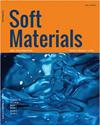紫外光诱导螺恶嗪光致变色聚合物的合成与性能
IF 1.4
4区 材料科学
Q4 MATERIALS SCIENCE, MULTIDISCIPLINARY
引用次数: 1
摘要
螺-恶嗪(SO)特殊的光致变色机理是其热稳定性低、抗疲劳能力弱。高透光性和生物相容性是聚甲基丙烯酸甲酯(PMMA)的两大优点,但在抗拉强度方面表现不佳。本文合成了一种新型的SO(1-(4′甲基丙烯酰氧基)- 3,3-二甲基-9′-羟基- 3h -螺-萘酰恶嗪),并将其作为光致变色单体引入到甲基丙烯酸甲酯(MMA)体系中,这是一种环保的方法。与已报道的其他光致变色聚合物相比,该材料的优点主要表现在:(1)将活性基团引入到SO的n -烷基链中,与PMMA共聚,光致变色聚合物的褪色率比SO降低了76.3%。(2)采用物理和化学方法提高PMMA-SO的柔韧性。聚合物的抗拉强度降至3.92 MPa。断裂伸长率高达269.84%。(3) PMMA-SO在紫外线和可见光照射25次后仍具有显著的抗疲劳性能。未来,它在智能玻璃、数据存储、仿生材料等领域具有潜在的应用前景。图形抽象本文章由计算机程序翻译,如有差异,请以英文原文为准。
Synthesis and properties of photochromic polymer contain spiro-oxazine induced by ultraviolet light
ABSTRACT The special photochromic mechanism of spiro-oxazine (SO) refers to low thermostability and weak fatigue resistance. High light transmittance and biocompatibility are the two advantages of polymethyl methacrylate (PMMA), but it does not perform well in terms of tensile strength. Here, a new type of SO (1-(4'methacryloyloxybutyl)- 3,3-dimethyl-9'-hydroxy- 3H-spiro-naphthyl oxazine) was synthesized and introduced as a photochromic monomer into methyl methacrylate (MMA) system, which is an environment-friendly method. Compared with other photochromic polymers that have been reported, the advantages of this material mainly perform in the following areas: (1) The active group was introduced into the N-alkyl chain of SO and copolymerized with PMMA, and the fading rate of the photochromic polymer was dropped by 76.3% compared to SO. (2) Physical and chemical methods were used to improve the flexibility of PMMA-SO. The tensile strength of polymers has been reduced to 3.92 MPa. It also has a high elongation of 269.84% at a break. (3) PMMA-SO still has a significant fatigue resistance after 25 cycles of UV and visible light irradiation. In the future, it has potential applications in the fields of smart glass, data storage, biomimetic materials, and so on. Graphical abstract
求助全文
通过发布文献求助,成功后即可免费获取论文全文。
去求助
来源期刊

Soft Materials
工程技术-材料科学:综合
CiteScore
2.90
自引率
0.00%
发文量
21
审稿时长
2.2 months
期刊介绍:
Providing a common forum for all soft matter scientists, Soft Materials covers theory, simulation, and experimental research in this rapidly expanding and interdisciplinary field. As soft materials are often at the heart of modern technologies, soft matter science has implications and applications in many areas ranging from biology to engineering.
Unlike many journals which focus primarily on individual classes of materials or particular applications, Soft Materials draw on all physical, chemical, materials science, and biological aspects of soft matter. Featured topics include polymers, biomacromolecules, colloids, membranes, Langmuir-Blodgett films, liquid crystals, granular matter, soft interfaces, complex fluids, surfactants, gels, nanomaterials, self-organization, supramolecular science, molecular recognition, soft glasses, amphiphiles, foams, and active matter.
Truly international in scope, Soft Materials contains original research, invited reviews, in-depth technical tutorials, and book reviews.
 求助内容:
求助内容: 应助结果提醒方式:
应助结果提醒方式:


